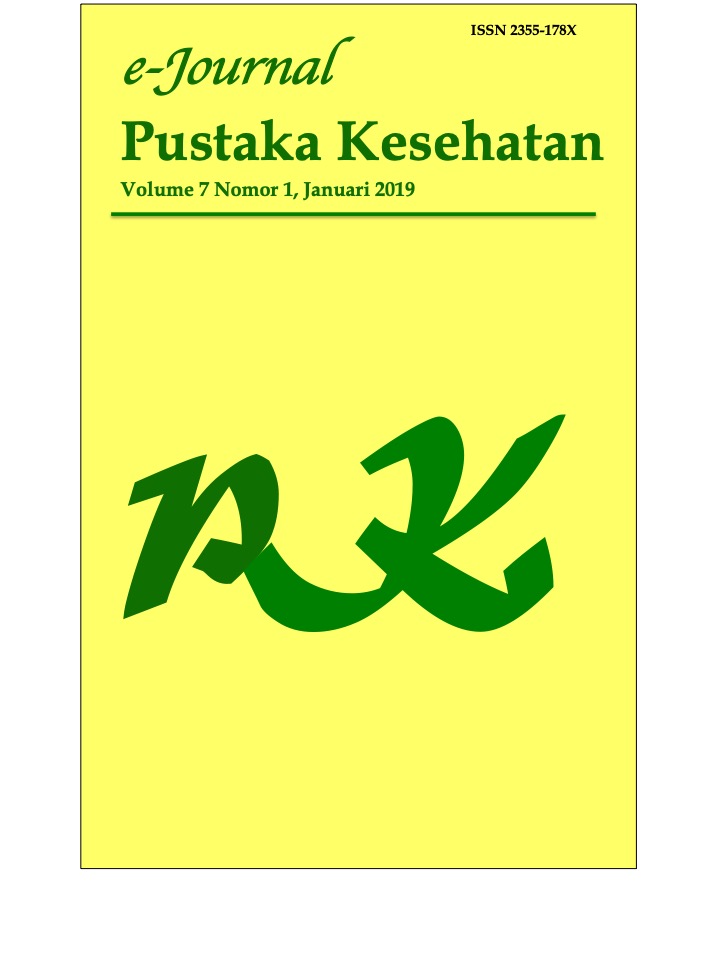Hubungan antara Berat Badan Berlebih dengan Terjadinya Sindrom Syok Dengue pada Anak di RSD dr. Soebandi, Jember
DOI:
https://doi.org/10.19184/pk.v7i1.17589Keywords:
Children, Dengue Shock Syndrome, OverweightAbstract
Dengue Shock Syndrome (DSS) is shock syndrome that happened in dengue hemorrhagic fever patients. There are risk factors that cause DSS. One of them is overweight in children. This study aimed to determine the relationship between overweight and the occurence of DSS. This retrospective case control study conducted at the dr. Soebandi Hospital Jember. Sampels were divided into DSS group (case group) and non-DSS group (control group). To analyze the data, Chi-Square test was performed using SPSS version 21. Aa many as 191 patients were included in this study which consisted of 132 patients as the control group and 59 patients as the case group. Chi-square analysis showed the p-value was 0,649. In conclusion, overweight was not significantly associated as a risk factor of DSS in children at the dr. Soebandi hospital.
Downloads
References
[2] Dinas Kesehatan Provinsi Jawa Timur [Internet]. Profil Kesehatan Provinsi Jawa Timur; 2013. [cited 2016 October 4] Available from http://dinkes.jatimprov.go.id.
[3] Flier JS, Maratos-Flier, E. Biology of Obesity. Dalam Harrison’s Principles of Internal Medicine. Editor A.S Fauci, D.L Kasper, D.L Longo, E. Braunwald, S.L Hauser, J.L Jameson, J. Loscalzo. America: McGraw-Hill; 2008.
[4] Louise, Mary. Immunology and Serology in Laboratory Medicine. Second Edition. America: Mosby; 1996.
[5] Rajapakse, Senaka. Dengue Shock. J Emerg Trauma Shock. 2011 Jan-Mar; 4(1): 120–127.
[6] Thisyakorn U, Nimmannitya S. Nutritional status of children with dengue hemorrhagic fever. Clin Infect Dis 1993;16:295-7.
[7] Pichainarong N, Mongkalangoon N, Katayanarooj S. Chaveepojnkamjorn W. Relationship between body size and severity of dengue hemorrhagic fever among children aged 0-14 years. Southlast Asian J Trop Med Public Health 2006;3:283-8.
[8] Elmy S, Arhana BNP, Suandi IKG, Sidiartha IGL. Obesitas Sebagai Faktor Risiko Sindrom Syok Dengue. Jurnal Sari Pediatri. 2009 Vol. 11, No. 4.
[9] Sutaryo. Dengue. Yogyakarta: Medika Fakultas kedokteran Universitas Gadjah Mada; 2004.
[10] Hung NT, Lan NT, Lei HY, Lin YS, Lein LB, Huang KJ. Association between sex, nutritional status, severity of dengue hemorrhagic fever, and immune status in infants with dengue hemorragic fever. Am J Trop Med Hyg 2005 vol 72:370-4.
[11] Widiyawati MMT, Laksanawati IS, Prawirohartono EP. Obesity as a Risk Factor for Dengue Shock Syndrome in Children. Jurnal Paediatrica Indonesiana. 2013 vol. 53, no. 4.
[12] Ganda IJ, Boko SH, Daud D. Comparison of blood gases analysis in patient with dengue shock syndrome and dengue hemorrhagic fever. J Med Nus 2006;27:151-5.
[13] Dardjito E, Yuniarno S, Wibowo C, Saptaprasetya DL, Dwiyanti H. Beberapa Faktor Risiko yang Berpengaruh terhadap Kejadian Penyakit Demam Berdarah Dengue (DBD) di Kabupaten Banyumas. Media Litbang Kesehatan 2008 Vol XVIII no 3 (126-136).
[14] WHO. Dengue: Guidelines for Diagnosis, Treatment, Prevention and Control. Geneva: WHO; 2009.
[15] Vicente CR, Lauar JC, Santos BS, Cobe VM, Junior CC. Factors related to severe dengue during an epidemic in Vitoria, State of Espirito Santo, Brazil. Revista de Sociedade Brasileira de Medicina Tropical. 2013 vol 46(5):629-632.
[16] Pothapregada S, Kamalakannan B, Thulasingham M. Risk factors for shock in children with dengue fever. Indian Journal of Critical Care Medicine. 2015 vol 19:661-664.
[17] Blanton RE, Silva LK, Morato VG, Parrado AR, Dias JP. Genetic ancestry and income are associated with dengue hemorrhagic fever in a highly admixed population. Eur J Human Genetics. 2008 vol. 16:762-765.
[18] Tee HP, How SH, Jamalludin AR, Safhan MNF, Sapian MM, Kuan YC, Sapari S. Risk factors associated with development of dengue haemorrhagic fever or dengue shock syndrome in adults in hospital Tengku Ampuan Afzan Kuantan. Medical Journal Malaysia. 2009 vol. 64(4).
[19] Halstead, SB. Epidemiology of dengue and dengue hemorrhagic fever. In Gubler DJ, kuno G, eds. Dengue and dengue hemorrhagic fever. Wallingford, New York: CAB International; 1997.
[20] MarÏŒn GM, Clara AW, Diddle JW, Pleites EB, Miller L, MacDonald G, Adderson EE. Association between nutritional status and severity of dengue infection in children in El Salvador. American J Tropical Medicine and Hygiene. 2010 vol 82(2): 324-329.
[21] Trang NTH, Long NP, Hue TTM, Hung LP, Trung TD, Dinh DN, Luan NT, Huy NT, Hirayama K. Association between nutritional status and dengue infection: a systematic review and meta-analysis. BMC Infectious Diseases. 2016 vol 16:172.
[22] Marti A, Marcos A, Martinez JA. Obesity and immune function relationships. Obes Rev. 2001 vol 2(2): 131-40.
[23] Milner JJ, Beck MA. The impact of obesity on the immune response to infection. Proc Nutr Soc. 2012 vol 71: 298-302.
[24] Kalayanarooj S, Nimmannitya S. Is dengue severity related to nutritional status?. Southeast Asian J Trop Med Public Health. 2005 vol 36: 378-384.
[25] Gibson RS. Principles of Nutritional Assessment. Second Edition. New York: Oxford University Press; 2005.
[26] Kesetyaningsih TW, Ulfabriana A. Knowledge, behaviour and socio-economic status of community in dengue endemic areas with increase and stable trends in Sleman District, Yogyakarta, Indonesia. AIP Conference Proceeding. 2016 vol. 1744.
Downloads
Published
Issue
Section
License
e-Journal Pustaka Kesehatan has CC-BY-SA or an equivalent license as the optimal license for the publication, distribution, use, and reuse of scholarly work. Authors who publish with this journal retain copyright and grant the journal right of first publication with the work simultaneously licensed under a Creative Commons Attribution-ShareAlike 4.0 International License that allows others to share the work with an acknowledgment of the work's authorship and initial publication in this journal.



